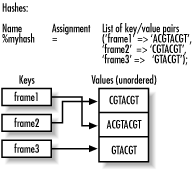 B.7 HashesA hash (also called an associative array) is a collection of zero or more pairs of scalar values, called keys and values. The values are indexed by the keys. An array variable begins with the percent sign % followed by a legal variable name. For instance, possible hash variable names are: %hash1 %genes_by_name You can assign a value to a key with a simple assignment statement. For example, say you have a hash called %baseball_stadiums and a key Phillies to which you want to assign the value Veterans Stadium. This statement accomplishes the assignment: $baseball_stadiums{'Phillies'} = 'Veterans Stadium';
Note that a single hash value is referenced by a $ instead of a % at the beginning of the hash name; this is similar to the way you reference individual array values by using a $ instead of a @. You can assign several keys and values to a hash by placing their scalar values in a list, separated by commas and surrounded by a pair of parentheses. Each successive pair of scalars becomes a key and a value in the hash. For instance, you can assign a hash the empty list: %hash = ( ); You can also assign one or more scalar key-value pairs: %genes_by_name = ('gene1', 'AACCCGGTTGGTT', 'gene2', 'CCTTTCGGAAGGTC');
There is an another way to do the same thing, which makes the key-value pairs more readily apparent. This accomplishes the same thing as the preceding example: %genes_by_name = ( 'gene1' => 'AACCCGGTTGGTT', 'gene2' => 'CCTTTCGGAAGGTC' ); To get the value associated with a particular key, precede the hash name with a $ and follow it with a pair of curly braces { } containing the scalar value of the key: $genes_by_name{'gene1'}
This returns the value 'AACCCGGTTGGTT', given the value previously assigned to the key 'gene1' in the hash %genes_by_name. Figure B-2 shows a hash with three keys. Figure B-2. Schematic of a hash
|
Index terms contained in this sectionhashesPerl hashes |